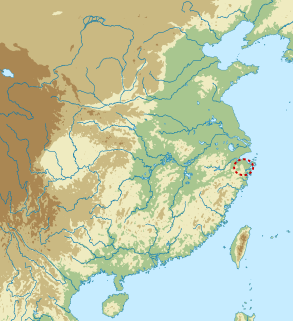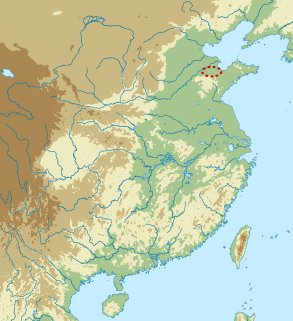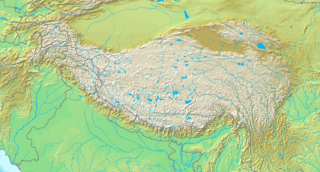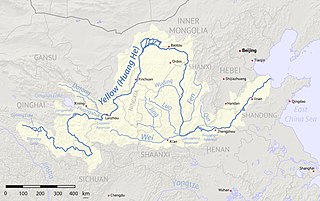 W
WBanpo is an archaeological site discovered in 1953 and located in the Yellow River Valley just east of Xi'an, China. It contains the remains of several well organized Neolithic settlements, like Jiangzhai, carbon dated to 6700–5600 years ago. The area of 5 to 6 hectares is surrounded by a ditch, probably a defensive moat, 5 to 6 meters wide. The houses were circular, built of mud and wood with overhanging thatched roofs. They sat on low foundations. There appear to be communal burial areas.
 W
WBanshan was a phase of the Chinese Neolithic Yangshao culture, c. 2600 to 2300 BC. The Banshan site is in Guanghe County, Gansu.
 W
WThe Baodun culture was a Neolithic culture centered on the Chengdu Plain in Sichuan, China.
 W
WBeifudi is an archaeological site and Neolithic village in Yi County, Hebei, China. The site, an area of 3 ha on the northern bank of the Yishui River, contains artifacts of a culture contemporaneous with the Cishan and Xinglongwa cultures of about 8000–7000 BP, two known Neolithic cultures east of the Taihang Mountains, and thus fills an archaeological gap between the two Northern Chinese cultures. The total excavated area is more than 1,200 square meters and the collection of neolithic findings at the site has been conducted in two phases.
 W
WThe Beixin culture was a Neolithic culture in Shandong, China. It was the successor of the Houli culture and precursor of the Dawenkou culture.
 W
WChengziya, also spelled Chengziyai, is a Chinese archaeological site and the location of the first discovery of the neolithic Longshan culture in 1928. The discovery of the Longshan culture at Chengziya was a significant step towards understanding the origins of Chinese civilization. Chengziya remains the largest prehistorical settlement found to date. The site is located in Shandong province, about 25 kilometres (16 mi) to the east of the provincial capital Jinan. It is protected and made accessible by the Chengziya Ruins Museum.
 W
WThe Cishan culture was a Neolithic culture in northern China, on the eastern foothills of the Taihang Mountains. The Cishan culture was based on the farming of broomcorn millet, the cultivation of which on one site has been dated back 10,000 years. The people at Cishan also began to cultivate foxtail millet around 8700 years ago. However, these early dates have been questioned by some archaeologists due to sampling issues and lack of systematic surveying. There is also evidence that the Cishan people cultivated barley and, late in their history, a japonica variety of rice.
 W
WThe Dadiwan culture was a Neolithic culture located primarily in the eastern portion of Gansu and Shaanxi provinces in modern China. The culture takes its name from the deepest cultural layer found during the original excavation of the type site at Dadiwan. The remains of millet, pigs and dogs have been found in sites associated with the culture, which is itself defined by a thin-walled, cord-marked ceramic tradition sometimes referred to as Laoguantai. The site has continued to produce new information about the Dadiwan culture, for example, recent biogeochemical analyses reveal that dogs living at Dadiwan from 7900–4900 calBP likely consumed C4 carbon fixation plants throughout the year. Because all other wild animals found at the site only consumed C3 plants, it suggests that the natural year-round vegetation was dominated by C3 plants. The only way that dog bones would contain strong C4 signals was if they consumed a rare plant year-round. A likely candidate for this is millet ; and because millet only grows in the summer, the only way that dogs could eat it year round is if humans were feeding it to them. Therefore, this represents some of the earliest evidence for agricultural production in East Asia. The Dadiwan culture shares a variety of common features, in pottery, architecture, and economy, with the Cishan and Peiligang cultures of eastern China.
 W
WThe Dawenkou culture is a name given by archaeologists to a group of Neolithic communities who lived primarily in Shandong, but also appeared in Anhui, Henan and Jiangsu, China. The culture existed from 4100 to 2600 BC, co-existing with the Yangshao culture. Turquoise, jade and ivory artefacts are commonly found at Dawenkou sites. The earliest examples of alligator drums appear at Dawenkou sites. Neolithic signs, perhaps related to subsequent scripts, such as those of the Shang Dynasty, have been found on Dawenkou pottery.
 W
WThe Daxi culture was a Neolithic culture centered in the Three Gorges region around the middle Yangtze, China. The culture ranged from western Hubei to eastern Sichuan and the Pearl River Delta. The site at Daxi, located in the Qutang Gorge around Wushan, Chongqing, was discovered by Nels C. Nelson in the 1920s. Many key archaeological sites from the Daxi culture, including the site at Daxi, were inundated or destroyed after the completion of the Three Gorges Dam.
 W
WThe Hemudu culture was a Neolithic culture that flourished just south of the Hangzhou Bay in Jiangnan in modern Yuyao, Zhejiang, China. The culture may be divided into early and late phases, before and after 4000 BC respectively. The site at Hemudu, 22 km northwest of Ningbo, was discovered in 1973. Hemudu sites were also discovered at Tianluoshan in Yuyao city, and on the islands of Zhoushan. Hemudu are said to have differed physically from inhabitants of the Yellow River sites to the north. Some authors propose that the Hemudu Culture was a source of the pre-Austronesian cultures.
 W
WThe Hongshan culture was a Neolithic culture in the Liao river basin in northeast China. Hongshan sites have been found in an area stretching from Inner Mongolia to Liaoning, and dated from about 4700 to 2900 BC.
 W
WThe Houli culture was a Neolithic culture in Shandong, China. The people of the culture lived in square, semi-subterranean houses. The most commonly found artefacts at Houli sites are pottery and stone tools. Jade artefacts and bone, antler, shell tools were also found at Houli sites. While the remains of domesticated dogs and pigs in the early stages of domestication were found at some sites associated with the culture, the people of the Houli culture relied mostly on hunting and fishing. The remains of rice, broomcorn millet, and foxtail millet were discovered at Houli sites.
 W
WJiahu was the site of a Neolithic settlement based in the central plain of ancient China, near the Yellow River. It is located between the floodplains of the Ni River to the north, and the Sha River to the south, 22 km (14 mi) north of the modern city of Wuyang, Henan Province. Most archaeologists consider the site to be one of the earliest examples of the Peiligang culture. Settled around 7000 BC, the site was later flooded and abandoned around 5700 BC. The settlement was surrounded by a moat and covered a relatively large area of 55,000 square meters. At one time, it was "a complex, highly organized Chinese Neolithic society," home to at least 250 people and perhaps as many as 800.
 W
WThe Karuo culture was a Neolithic culture in Tibet. The culture cultivated foxtail millet.
 W
WThe Kuahuqiao site is an early neolithic site of Kuahuqiao culture near Xianghu village, Xiaoshan District, in suburban Hangzhou, Zhejiang, China. It was first discovered in the early 1970s during the construction of a local brick factory, which destroyed a large part of the site. But the professional excavations first started in 1990.
 W
WThe Liangzhu culture was the last Neolithic jade culture in the Yangtze River Delta of China. The culture was highly stratified, as jade, silk, ivory and lacquer artifacts were found exclusively in elite burials, while pottery was more commonly found in the burial plots of poorer individuals. This division of class indicates that the Liangzhu period was an early state, symbolized by the clear distinction drawn between social classes in funeral structures. A pan-regional urban center had emerged at the Liangzhu city-site and elite groups from this site presided over the local centers. The Liangzhu culture was extremely influential and its sphere of influence reached as far north as Shanxi and as far south as Guangdong. Liangzhu site was perhaps among the oldest Neolithic sites in East Asia that would be considered a state society. The type site at Liangzhu was discovered in Yuhang County, Zhejiang and initially excavated by Shi Xingeng in 1936. A 2007 analysis of the DNA recovered from human remains shows high frequencies of Haplogroup O1 in Liangzhu culture linking this culture to modern Austronesian and Tai-Kadai populations. It is believed that the Liangzhu culture or other associated subtraditions are the ancestral homeland of Austronesian speakers.
 W
WThe Longshan culture, also sometimes referred to as the Black Pottery Culture, was a late Neolithic culture in the middle and lower Yellow River valley areas of northern China from about 3000 to 1900 BC. The first archaeological find of this culture took place at the Chengziya Archaeological Site in 1928, with the first excavations in 1930 and 1931. The culture is named after the nearby modern town of Longshan in Zhangqiu, Shandong. The culture was noted for its highly polished black pottery. The population expanded dramatically during the 3rd millennium BC, with many settlements having rammed earth walls. It decreased in most areas around 2000 BC until the central area evolved into the Bronze Age Erlitou culture.
 W
WThe Majiabang culture was a Chinese Neolithic culture that existed at the mouth of the Yangtze River, primarily around Lake Tai near Shanghai and north of Hangzhou Bay. The culture spread throughout southern Jiangsu and northern Zhejiang from around 5000 BC to 3300 BC. The later part of the period is now considered a separate cultural phase, referred to as the Songze culture.
 W
WThe Majiayao culture was a group of neolithic communities who lived primarily in the upper Yellow River region in eastern Gansu, eastern Qinghai and northern Sichuan, China. The culture existed from 3300 to 2000 BC. The Majiayao culture represents the first time that the upper Yellow River region was widely occupied by agricultural communities and it is famous for its painted pottery, which is regarded as a peak of pottery manufacturing at that time.
 W
WThe Peiligang culture was a Neolithic culture in the Yi-Luo river basin that existed from 7000 to 5000 BC. Over 100 sites have been identified with the Peiligang culture, nearly all of them in a fairly compact area of about 100 square kilometers in the area just south of the river and along its banks.
 W
WThe Pengtoushan culture was a Neolithic culture located around the central Yangtze River region in northwestern Hunan province, China. It dates to around 7500–6100 BC, and was roughly contemporaneous with the Peiligang culture to the north. It is named after the type site at Pengtoushan.
 W
WThe Qujialing culture was a Neolithic civilisation centered primarily around the middle Yangtze River region in Hubei and Hunan, China. The culture succeeded the Daxi culture and reached southern Shaanxi, northern Jiangxi and southwest Henan. Artefact types unique to the culture include ceramic balls and painted spindle whorls; the later was inherited by the succeeding Shijiahe culture.
 W
WThe Shijiahe culture was a late Neolithic culture centered on the middle Yangtze River region in Shijiahe Town, Tianmen, Hubei Province, China. It succeeded the Qujialing culture in the same region and inherited its unique artefact of painted spindle whorls. Pottery figurines and distinct jade worked with advanced techniques were also common to the culture.
 W
WThe Songze Culture was a Neolithic culture that existed between 3800 and 3300 BCE in the Lake Tai area near Shanghai.
 W
WThe Xinglongwa culture (興隆洼文化) was a Neolithic culture in northeastern China, found mainly around the Inner Mongolia-Liaoning border at the Liao River basin. Xinglongwa pottery was primarily cylindrical, and baked at low temperatures.
 W
WThe Yangshao culture was a Neolithic culture that existed extensively along the Yellow River in China. It is dated from around 5000 BC to 3000 BC. The culture is named after Yangshao, the first excavated site of this culture, which was discovered in 1921 in Mianchi County, Henan Province by the Swedish geologist Johan Gunnar Andersson (1874–1960). The culture flourished mainly in the provinces of Henan, Shaanxi and Shanxi.
 W
WYangtze civilization is a generic name for various ancient Neolithic and Bronze Age cultures from the Yangtze basin of China, the representative civilization of the Chinese alongside the Yellow River civilization.
 W
WYellow River civilization or Huang civilization, Hwan‐huou civilization is an ancient Chinese civilization that prospered in the middle and lower basin of the Yellow River. Agriculture was started in the flood plain of the Yellow River, and before long, through flood control and the irrigation of the Yellow River, cities were developed and political power found reinforcement. One of the "four major civilizations of the ancient world", it is often included in textbooks of East Asian history, but the idea of including only the Huang civilization as one of the four biggest ancient civilizations has become outdated thanks to the discovery of other early cultures, such as the Chang Jiang and Liao civilizations. The area saw the Yangshao and Longshan cultures of the Neolithic era and developed into the bronze ware culture of the Yin and Zhou dynasties.
 W
WThe Yueshi culture was an archaeological culture in the Shandong region of eastern China, dated from 1900 to 1500 BC. It spanned the period from the Late Neolithic to the early Bronze Age. In the Shandong area, it followed the Longshan culture period, and was later replaced by the Erligang culture.
 W
WThe Zhukaigou culture was a late Neolithic and early Bronze Age culture centered in the Ordos Plateau of Inner Mongolia, China. The type site at Zhukaigou was discovered in Ejin Horo Banner, Inner Mongolia, and excavated from 1977 to 1984. Zhukaigou culture is a reputed progenitor of the Ordos bronze culture and accordingly a first "Northern Zone" culture, extending to northern and central Inner Mongolia, northern Shaanxi, and northern Shanxi, with the Ordos region at its center. Transition to metalworking is dated to around the end of the third millennium BCE, at the same time was attained a higher level in the ceramic. Zhukaigou culture lasted to c. 1500 BCE.